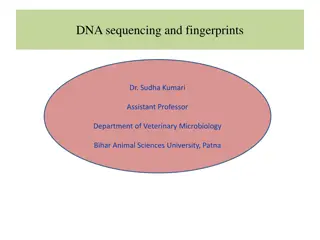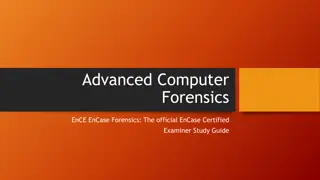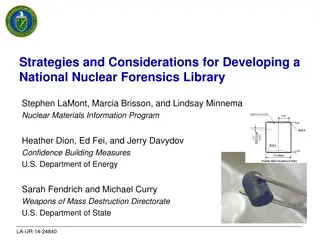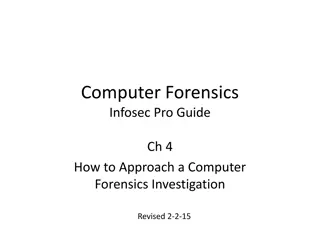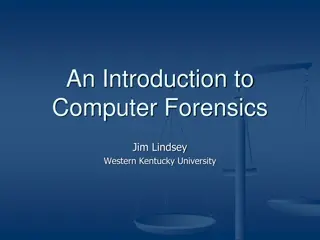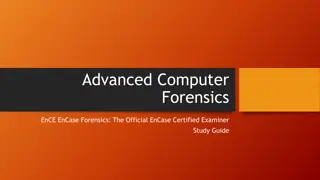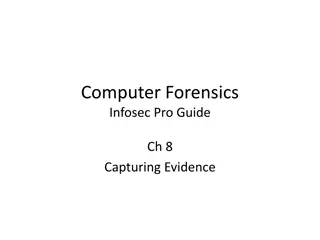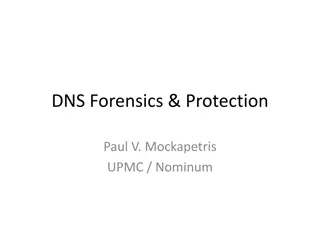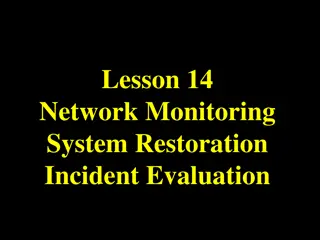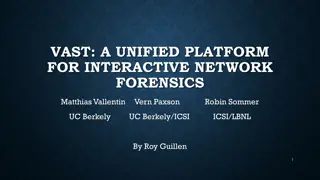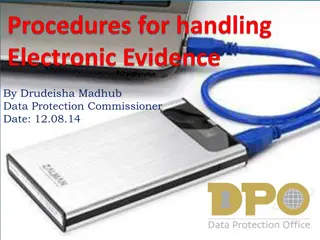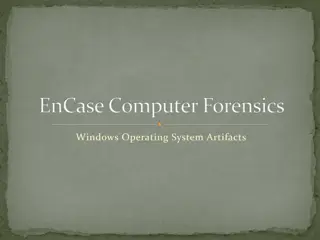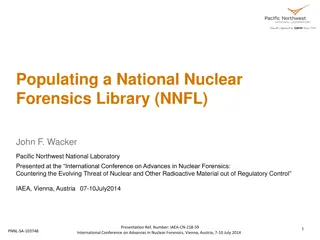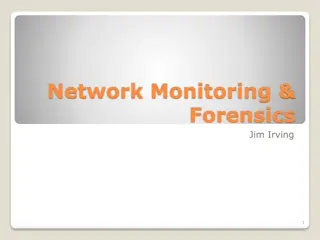Apache MINA: High-performance Network Applications Framework
Apache MINA is a robust framework for building high-performance network applications. With features like non-blocking I/O, event-driven architecture, and enhanced scalability, MINA provides a reliable platform for developing multipurpose infrastructure and networked applications. Its strengths lie i
3 views • 13 slides
Modeling and Generation of Realistic Network Activity Using Non-Negative Matrix Factorization
The GHOST project focuses on the challenges of modeling, analyzing, and generating patterns of network activity. By utilizing Non-Negative Matrix Factorization (NMF), realistic network activity patterns can be created and injected into live wireless networks. Understanding and predicting user behavi
4 views • 28 slides
Automated Anomaly Detection Tool for Network Performance Optimization
Anomaly Detection Tool (ADT) aims to automate the detection of network degradation in a mobile communications network, reducing the time and effort required significantly. By utilizing statistical and machine learning models, ADT can generate anomaly reports efficiently across a large circle network
8 views • 7 slides
Expert Cybersecurity and Digital Forensics Consultants
Protect your digital assets with expert cybersecurity and digital forensics consulting from AliasCybersecurity.com. Our team of specialists will keep your data secure..\n\n\/\/aliascybersecurity.com\/
2 views • 1 slides
Malware Forensic in Malaysia
OGIT Forensics, a leading Cyber Crime Forensic service in Malaysia, specializes in social networking analysis, security intelligence, mobile phone forensic, computer forensic, and audio-video forensic services. Our adept team conducts in-depth digital investigations, delivering accurate and efficien
1 views • 1 slides
Revolutionizing Network Management with Intent-Based Networking
Explore the concept and benefits of Intent-Based Networking (IBN) in simplifying network configuration and enhancing efficiency. Learn how IBN automates network operations, aligns with business objectives, improves security, and ensures scalability and reliability. Discover the potential of IBN tool
0 views • 14 slides
Modernizing Forensics: Transforming Strategies for Better Justice
The field of forensics is evolving to meet new challenges and demands. Key drivers for change include systemic issues and the need for shared priorities in the forensic services marketplace. The response involves a national approach to deliver improved criminal justice outcomes, reduced harm, and in
1 views • 9 slides
Network Compression Techniques: Overview and Practical Issues
Various network compression techniques such as network pruning, knowledge distillation, and parameter quantization are discussed in this content. The importance of pruning redundant weights and neurons in over-parameterized networks is highlighted. Practical issues like weight pruning and neuron pru
0 views • 37 slides
Understanding DNA Sequencing: Principles, Applications, and Techniques
DNA sequencing plays a vital role in various fields such as research, diagnostics, biotechnology, forensics, and biological systematics. By determining the order of nucleotide bases in a DNA molecule, it helps in understanding genetic sequences, identifying mutations, and completing projects like th
0 views • 17 slides
Network Slicing with OAI 5G CN Workshop Overview
Overview of Network Slicing with OAI 5G CN workshop focusing on the crucial role of network slicing in realizing the service-oriented 5G vision. This workshop covers topics like multiple logical networks creation on shared infrastructure, different types of network slices, preparation and instantiat
1 views • 6 slides
Network Design Challenges and Solutions in Business Data Communications
Issues in designing a Local Area Network (LAN) include needs analysis, technological design, and cost assessment. The traditional approach involves structured systems analysis, but faces challenges due to rapidly changing technology and increasing network traffic. The Building Blocks Approach recomm
1 views • 20 slides
Expert Cybersecurity and Digital Forensics Consultants
Protect your digital assets with expert cybersecurity and digital forensics consulting from AliasCybersecurity.com. Our team of specialists will keep your data secure.\n\n\/\/aliascybersecurity.com\/
3 views • 1 slides
OGIT Forensics has the most up-to-date high-speed disperser solutions in Malaysi
OGIT Forensics has the most up-to-date high-speed disperser solutions in Malaysia. They are experts in live forensic analysis, picture forensic examination, mobile phone forensic investigations, malware forensic detection, and digital forensic knowle
0 views • 1 slides
EnCase Forensics: Official Study Guide Overview
Explore the key features of EnCase Forensics including the EnCase Environment, home screen navigation, browsing evidence, layout details, and case creation processes. Gain insights into working with evidence, templates, and custom options in a detailed manner to enhance your knowledge in computer fo
1 views • 32 slides
Understanding 5G RAN Network Slicing and Architecture
Explore the intricate world of 5G Radio Access Network (RAN) and Network Slicing, delving into concepts such as SO Service Orchestrator, SDN-C Service Design, and Core Network Elements. Discover the significance of managing and designing mobile slice services, including eMBB, Massive IoT, and Missio
0 views • 26 slides
Understanding Snort: An Open-Source Network Intrusion Detection System
Snort is an open-source Network Intrusion Detection System (NIDS) developed by Cisco, capable of analyzing network packets to identify suspicious activities. It can function as a packet sniffer, packet logger, or a full-fledged intrusion prevention system. By monitoring and matching network activity
0 views • 23 slides
Strategies for Developing a National Nuclear Forensics Library
Nuclear forensics involves comparing data from unknown sources with known material characteristics to determine their origin. Establishing a national nuclear forensics library is crucial for identifying nuclear materials and promoting international cooperation in investigations. Key elements include
0 views • 18 slides
Guide to Setting Up a Computer Forensics Lab
Explore the essential aspects of creating a computer forensics lab, including where to establish it, tools needed, forensic software, storing evidence, access controls, chain of custody, and recording details about forensic images. Learn about the differences between criminal and civil investigation
0 views • 36 slides
Digital Forensics Investigation Process Overview
Explore the essential steps and considerations involved in approaching a computer forensics investigation, from testing hypotheses to assessing available data sources and seeking appropriate authorization. Learn about data carving, handling sensitive issues like child pornography, and the importance
0 views • 49 slides
Biomedical Forensics: Solving Mysteries Through DNA Analysis
Explore the world of biomedical forensics with a focus on DNA extraction, blood typing, and fingerprinting techniques. Unravel murder mysteries using basic forensic skills and investigative procedures. Learn about the properties of DNA, forensic techniques like blood typing and fingerprinting, and t
0 views • 14 slides
Transportation Network Modeling and Analysis with C.Coupled SE Platform
This content outlines the features and functionalities of the C.Coupled SE Platform (CSET Platform) developed by the Connetics Transportation Group. It covers aspects such as interface design, inputs merging, purposes, platform development using Cube, TAZs merging, and network attributes. The platfo
0 views • 11 slides
Introduction to Computer Forensics: Uncovering Digital Evidence
Delve into the world of computer forensics with this comprehensive guide featuring key concepts, techniques, and tools used in investigating digital evidence for criminal and civil cases. Learn about the process of discovering, collecting, and analyzing data from computers and networks, as well as t
0 views • 17 slides
Exploring the Integration of Digital Forensics in Digital Curation Workflows
This content delves into the role of digital forensics within the digital curation workflow, examining how institutions can combine tools to meet local needs and implement handoffs between different systems. It also discusses the socio-technical factors and institutional drivers influencing decision
0 views • 27 slides
Understanding File Systems and Disk Basics in Computer Forensics
Explore the fundamentals of file systems and disk basics in computer forensics, covering topics such as disk preparation, partitioning, volume creation, file system formatting, FAT basics, and file allocation tables. Learn about disk structures, cluster allocation, and the functioning of FAT version
0 views • 24 slides
Computer Forensics: Capturing and Verifying Evidence
This guide focuses on the process of capturing and verifying digital evidence in computer forensics. Topics include creating forensic images of hard drives, using forensically sound methods, imaging internal hard drives, utilizing hardware write blockers, different types of forensic images, hashing
0 views • 28 slides
DNS Forensics & Protection: Analyzing and Securing Network Traffic
DNS Forensics involves using DNS traffic to analyze network health, detect anomalous behavior, and combat malicious activities. By understanding DNS activity on systems and implementing defense strategies, users and network providers can enhance security and privacy.
0 views • 16 slides
Meridian: An SDN Platform for Cloud Network Services
Meridian is an SDN platform developed by Mohammad Banikazemi, David Olshefski, Anees Shaikh, John Tracey, and GuohuiWang at IBM T. J. Watson Research Center. The platform focuses on providing cloud network services efficiently. It encompasses an architecture that enables faster and more convenient n
0 views • 21 slides
Network Forensics and Incident Response Overview
Explore the role of network forensics in incident response, focusing on the analysis tools that reveal insecurities in networks. Understand the importance of chain of custody in maintaining electronic evidence integrity and learn about monitoring network data for effective security measures.
0 views • 27 slides
Understanding Network Analysis: Whole Networks vs. Ego Networks
Explore the differences between Whole Networks and Ego Networks in social network analysis. Whole Networks provide comprehensive information about all nodes and links, enabling the computation of network-level statistics. On the other hand, Ego Networks focus on a sample of nodes, limiting the abili
0 views • 31 slides
VAST: A Unified Platform for Interactive Network Forensics
VAST is a comprehensive platform designed for interactive network forensics, addressing the increasing frequency of security incidents and large-scale data breaches. It aims to provide solutions for detecting, analyzing, and preventing breaches efficiently, with features like data exploration, query
0 views • 17 slides
Digital Evidence Processing and Computer Forensics Overview
Discover the importance of electronic evidence in high-tech investigations, the principles guiding its handling, and the step-by-step process involved in processing digital evidence. Learn about the critical role of trained personnel and the need for ongoing training in the dynamic field of computer
0 views • 20 slides
Digital Forensics: Date and Time Analysis in Computer Systems
Conducting date and time analysis in computer forensics is essential to verify evidence accuracy. Tasks include adjusting time zone offsets, accessing registry keys, and adjusting zone settings for data integrity. Understanding timestamps aids in investigations for legal purposes.
0 views • 35 slides
Network Function Virtualization (NFV) Overview
Network Function Virtualization (NFV) focuses on virtualizing network functions to improve efficiency and reduce costs in network infrastructure. The lecture discusses key readings, devices that compose a network, specialization of devices, benefits of one-device-does-anything approach, and the goal
0 views • 21 slides
Enhancing Network Stability with Network Monitoring Systems
Network monitoring is crucial for efficient management and proactive issue detection in a network environment. Factors influencing an effective network system include choosing the best OEM, SLA agreements, and selecting a reliable System Integrator. Reactive monitoring can lead to financial losses a
0 views • 12 slides
Insights into Information Terrorism from IT Forensics Perspective
Delve into the world of terrorism and information technology through the lens of IT forensics. Explore topics such as the uncertainties surrounding cybersecurity and digital crimes, the role of security players, Locard's Exchange Principle, computer investigations, evidence analysis, investigator qu
0 views • 15 slides
Effective Presentation Skills and Hair Analysis in Forensics
Good presenters engage their audience by knowing their subject well, showing passion, and utilizing effective communication strategies such as storytelling and emotion. Examples of successful presenters like Julian Treasure and Ken Robinson demonstrate these skills. On the other hand, poor presentat
0 views • 8 slides
National Nuclear Forensics Library Development Overview
The presentation highlights the establishment of the National Nuclear Forensics Library (NNFL) aimed at enhancing nuclear material identification and tracking to counter potential threats. It discusses the approach, goals, and challenges of developing a comprehensive inventory of nuclear materials,
0 views • 20 slides
Accelerating Systemic Change Network Inaugural Workshop Summary
The Accelerating Systemic Change Network held its inaugural workshop at Howard Hughes Medical Institute in July 2016 to address the lack of coordination in improving higher education. With a vision to become a professional hub for change researchers in STEM education, the network aims to enhance ind
0 views • 5 slides
University Network Section Overview July 2015 - March 2016
The presentation covers the network team structure, team members, objectives, goals, report outline, network statistics, accomplishments, and future plans of the university network section from July 2015 to March 2016. It highlights efforts to provide stable internet and intranet services, restructu
0 views • 16 slides
Comprehensive Network Forensics Course Overview
Explore the essentials of network monitoring, forensics, and analysis in this detailed course by Jim Irving. Learn about network events capture, forensic data interpretation, working with PCAP and flow data, host forensics, logs, alerts, SIEMs, and more. Gain a broad understanding of network forensi
0 views • 102 slides








